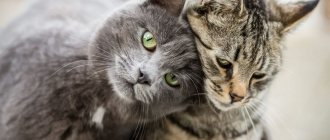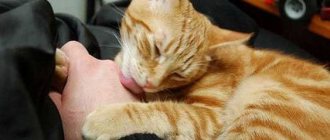It’s unlikely that anyone would argue that most people love cats. Of course, there are also dog lovers. But as statistics show, kittens and children still cause more affection.
Cats decorate our lives, making it warmer and more comfortable. They fill our home with joy and playful games; in difficult moments they can be wonderful interlocutors and listeners. Most often they get along well with children and tolerate all their pranks and jokes on them; can be both a nanny and a teacher. And on cold, cloudy and sad days, curled up on our laps, they serve us as an excellent cure for any blues.
But what can you do when suddenly something goes wrong with this sweet positivity?
What does a healthy animal look like?
The absence of health problems will be indicated by the behavior and appearance of the pet. Focus on good appetite and playfulness, as well as the condition of the coat, nose and color of mucous membranes. If the cat is not sick, then he will not refuse the offered treats and chasing the teaser rod, and will also purr with pleasure after scratching and stroking.
When assessing activity level, do not forget about individuality. Not all breeds are famous for their mobility, but you can notice changes even in mustachioed couch potatoes.
The main asset of all representatives of the cat family is their fur coat. If it shines and shimmers in the light, then there is no reason to worry. The same applies to a wet and cold nose, as well as pale pink mucous membranes of the mouth and eyes.
Nausea and vomiting
Vomiting is normal in felines. With its help, they get rid of fur that gets into the stomach during licking. A veterinarian's consultation is needed if the animal vomits several times a day, feels sick and has excessive salivation.
Based on the state of the vomit, a possible cat disease is determined:
- if it is yellow – gastrointestinal disorder;
- cloudy green color with an unpleasant odor - infection;
- the presence of blood indicates possible internal bleeding, neoplasms in the gastrointestinal tract, injuries to the oral cavity and pharynx;
- foamy – gastrointestinal diseases;
- with a lot of mucus – worms;
- with a strong unpleasant odor - constipation.
The factor of possible poisoning should not be ruled out, so monitor your pet’s diet so as not to cause gastrointestinal upset.
How to tell if your cat is sick: warning signs
It is quite easy to recognize illness if you know the main signs that appear in a sick cat. They are divided into physiological and behavioral.
Please note: Do not wait until all of the above to contact your veterinarian. For concern, 2 alarming symptoms are enough.
Drowsiness and lethargy
On average, mustachioed pets sleep 12-16 hours a day. Despite this, they spend most of their time dozing.
In addition to an increase in sleep duration, the disease causes less sensitive sleep and a more inhibited reaction to stimuli. A healthy cat responds with almost lightning speed to touches and sneaking up from behind, while a sick cat either ignores it or is frightened by surprise.
Another important symptom is a decrease in activity. Lethargy and indifference often go together with high fever and intoxication.
Refusal to eat, even your favorite treat
If your pet is not picky, then you will notice this sign first. Its severity depends on the severity of the condition. The cat may simply be a little undereaten with the main food, but agree to a meat stick - or flatly refuse any food, regardless of its taste.
Please note! Against the background of refusal of normal food, pica may develop - eating inedible objects: soil, filler, wallpaper.
Increase or decrease in temperature
A cat's body temperature is higher than that of a human. It is 37.5-38.9°C and depends on age. In kittens it can reach 39.5°C, as their metabolic processes work faster.
The most dangerous deviations include everything below 37°C and everything above 40°C. You can check the value using rectal measurement with an electronic or mercury thermometer.
The desire to hide
This sign is due to the instinct of self-preservation. A sick cat will try to hide in dark and confined spaces to protect itself from predators. Out of fear, she may not respond to the owner’s call and may not respond to bait with her favorite treat.
Increased aggression
The reverse version of apathy is increased aggression. It may be associated with pain and reluctance to communicate - or with disorders in the nervous system. The most dangerous cause is rabies. This disease cannot be cured and poses a danger to all family members.
Important! In addition to mood changes, rabies is accompanied by photophobia and hydrophobia, as well as increased salivation.
Meowing as a sign of pain
Loud meows, not associated with begging for food or communication, are used to express pain. The animal may meow due to painful touch, during urination, or for no obvious reason if the discomfort is already constant.
Strange pose
When feeling unwell, cats often “pull themselves up” and tuck their paws under themselves, taking the “loaf” pose. If the condition is accompanied by pain, then they constantly change their position, trying to minimize the feeling of discomfort in rather strange and unnatural positions.
Discharge from the eyes and nose, drooling
The discharge varies in abundance and consistency. The most dangerous are purulent and hemorrhagic, that is, with blood. They are characteristic of infections, injuries and tumors. Regardless of the clinical picture, this sign always indicates a disease, since natural mucous discharge is almost invisible.
Excessive salivation can be easily identified by a wet chest and deterioration in the quality of the coat. It occurs when a foreign object gets stuck in the respiratory tract, due to dental diseases, poisoning and rabies.
Digestive problems – vomiting, diarrhea or constipation
All these signs accompany intoxication, but its causes can be very diverse. Isolated cases of vomiting, diarrhea or constipation due to a change in diet are not dangerous, but frequent and prolonged cases are fraught with death from dehydration or intestinal rupture.
Foreign matter in stool or urine
In addition to stool disturbances, one should also be wary of the appearance of foreign matter: mucus, bile, blood, parasites. The same applies to changes in the color and smell of feces.
In diseases of the genitourinary system, problems with urination are observed. If stones are to blame, then the animal experiences numerous microtraumas to the mucous membranes. In addition to severe pain, this condition is characterized by blood in the urine and urination in inappropriate places.
Poor coat and/or skin condition
If your pet’s fur begins to fall out, roll into tangles, stick together into icicles, or simply loses its shine and softness, sound the alarm. All this is typical for allergies, parasitosis and other dangerous pathologies.
You shouldn’t ignore what’s underneath the fur. Too dry skin with various rashes, redness and ulcers is very far from the norm. Particularly dangerous are wounds formed due to scratching against a background of itching. Pathogenic microorganisms can penetrate them.
Loss of coordination, seizures, unsteady gait
These symptoms occur with problems with the musculoskeletal system (arthritis, injuries) and neurological disorders. If your pet rolls over on its side, drags its paws, or avoids using one of its limbs, seek help to avoid developing paralysis.
You shouldn’t hesitate even if you have cramps. One of the possible causes is an acute form of poisoning. To save the animal, it may be necessary to administer an antidote.
Breathing problems, cough
In the absence of pathologies, the cat's breathing is very quiet and almost imperceptible. On average, he takes 20-40 breaths per minute, so changes in frequency, the appearance of extraneous noise during inhalation and exhalation, as well as protruding of the tongue are considered deviations. Remember that shortness of breath, wheezing, whistling and gurgling sounds should not be ignored.
Change in mucous color
It was already said above that the only healthy color is pale pink. Its change to yellow, blue and white is a serious reason to contact the veterinarian.
Emergencies.
Certain situations require IMMEDIATE action. You should immediately go to or call a veterinarian when any of the following happens to your cat. In this case, keep information about the veterinarians closest to you at hand, in case you need urgent specialist help.
- Trauma (such as falling from a height or being hit by a car)
- Labored breathing
- Gums become blue, white, or very pale
- Labored breathing
- Collapse, loss of consciousness
- Seizure
- Dizziness
- Loss of ability to walk
- Heavy bleeding
- Exposure to a toxic substance
- Severe pain (as indicated by, for example, loud screaming or aggressive behavior when touched)
- High body temperature
If you notice something that bothers your cat, remember better to play it safe. At a minimum, you can call your veterinarian for advice.
What should the owner do first?
If you notice the signs listed above and are sure that your cat is sick, give him first aid. Acceptable actions will depend on the age and condition of the patient.
Help the kitten
The kitten's body is the most vulnerable. They get sick easily and are very difficult to tolerate illness themselves. Due to weaker immunity, death from a virus or other dangerous pathogen can occur within the first day.
If your kitten is sick, do not hesitate to consult a doctor. Attempts to independently relieve symptoms will only delay his death, but will not solve the main problem. There is also a risk of aggravating the condition with improper treatment.
Helping an adult pet
The situation with an adult cat is less critical, so just go by its condition. If it is not critical, wait a couple of days to observe. For mild food poisoning and other non-dangerous causes, the problem will resolve itself.
If you suspect a head injury or poisoning, as well as if there is no improvement or a stable deterioration in your health, immediately seek help from a veterinary clinic. There's no point in waiting here. Do the same if you have the following symptoms:
- bleeding;
- purulent discharge;
- repeated vomiting and stool with foreign inclusions;
- fainting, convulsions and paralysis;
- blanching or blue discoloration of mucous membranes;
- temperature too low or too high;
- labored breathing.
If you have any doubts, contact your doctor by phone. He will tell you whether it is worth taking the animal for examination right now and what can be done to improve its condition at home.
Causes of pathologies in cats
Signs of the disease appear in cats with a weak protective immune system. A young cat often gets sick because its immunity has not yet fully developed and is not able to resist pathogenic microorganisms. Various irritants can also affect diseases in cats, as a result of which pets develop an allergic reaction. A cold nose and other symptoms of the disease can occur due to the following reasons:
- severe hypothermia of the cat's body;
- infection with bacteria, viruses and other pathogenic microorganisms;
- parasite activity;
- congenital anomalies;
- unbalanced diet;
- unfavorable living conditions.
Contacting a veterinarian
Once you are convinced that a personal consultation with your veterinarian is necessary, schedule an examination and carefully place your pet in the carrier. To minimize stress and discomfort, it is better to get to the clinic by your own car or taxi.
ADVICE!
Bring a sample of vomit and feces with you, and if possible, collect some fresh urine in the container. All this will help in making a diagnosis.
The importance of diagnostics in a clinical setting
To determine the exact cause of the malaise, it is necessary to undergo tests and undergo a series of instrumental studies. They allow you to exclude diseases with similar symptoms, which is completely impossible at home.
Purpose of treatment
Depending on the diagnosis, the veterinarian may offer two treatment options: surgical and conservative. The first option is used in the most severe cases, when medication is not effective.
The main goal of treatment is to eliminate the cause of the disease. If it is an infection, then antibiotics, antivirals and antimycotics are prescribed to destroy the pathogen. All other medications are used to relieve associated symptoms.
IMPORTANT!
Never use medications from your own medicine cabinet. Most of them are toxic to animals.
Care and diet
The patient must be given rest and put on a diet in order to reduce the load on the weakened body. The rest of the recommendations are individual. If dermatological diseases are detected, regular treatment of the affected areas is required, and if the eyes are affected, moisturizing and cleansing the mucous membranes is required.
Condition of the mouth, eyes, skin
One of the serious cat diseases is lichen. It is difficult to diagnose in long-haired breeds. The main symptom is hair loss. With diseases, it becomes dull and rolls into tangles. Long-haired cats require special care. Skin diseases caused by increased sebum production are common among Sphynx cats. Acne is a result of stress or poor hygiene.
Cats may have dandruff caused by unfavorable environmental factors or fungal diseases. Dry skin becomes due to lack of moisture in the body.
If your cat's eyes are watery, this could be a sign of allergies or sinusitis. The combination of lacrimation, frequent or infrequent urination and somatic weakness are signs of renal failure. A particularly alarming sign is constantly dilated pupils.
If the gums are pale and there is an unpleasant odor from the mouth, this indicates a possible disease. If you have the above-described signs, you should show your cat to a specialist.
Diseases dangerous to humans
First of all, you should be wary of infections. Their pathogens are very contagious and can be transmitted not only from animals to animals, but also to humans. Such diseases include:
- trichophytosis;
- rabies;
- helminthiases;
- flea and tick infestations;
- toxoplasmosis;
- salmonellosis.
If your cat is sick, be sure to quarantine her in a separate room BEFORE diagnosis. Wash your hands thoroughly with soap and water after each handling and cleaning of the tray to minimize the chance of infection.
Preventive measures
It is not difficult to prevent the occurrence of diseases in cats: periodically visit the veterinarian for examination. Better once every quarter or six months. A specialist will advise you when certain vaccinations should be given.
Nutrition should be balanced, containing the necessary micro and macroelements and vitamins. Make sure that the animal does not overeat; the serving size should correspond to the age and size of the pet. If your cat periodically walks outside, purchase a flea collar and be more careful about hygiene. For long-haired breeds, purchase suitable grooming products.
Please rate!
[kkstarratings]
[evc_social_likes]
Useful tips
Remember - a cat is also a member of the family and requires close attention, communication and feeding. Only by following our recommendations will a healthy, intelligent animal live next to you, who will accompany you in the morning and meet you in the evening.
Feed only fresh food when necessary. add vitamins and minerals to your diet. The cat loves freedom, think about how it can safely walk in the city; in the private sector it is easier. In an apartment, an open window can kill a cat, because outside the window is an unknown world of adventure and freedom. It is advisable to hang a mosquito net on the windows.
Play with your cat as often as possible; you can hang a rag doll on a string so that she can play with it in your absence. Show her a soft rubber ball, they will happily bounce it around the room.
Body temperature
A rectal thermometer is used to measure temperature. If the animal resists, they try to calm it down. A temperature of 37.7 to 39.4°C is considered normal. When the temperature rises, the pet refuses food and drinks water greedily. A playful pet, hides, sleeps long and soundly. The nose is dry and warm.
The body tries to reduce the temperature, shortness of breath appears. If in doubt, consult a doctor. A false alarm is better than ignoring symptoms.
Viral diseases
Most viral diseases can be effectively prevented through vaccination. Among the most dangerous are rabies, infectious panleukopenia (feline distemper), coronaviruses and calcivirosis. In some cases, these diseases can quickly kill a pet. Many viral diseases are characterized by fever, vomiting, diarrhea, and ulceration. Infection usually occurs through contact with a sick animal. Antiviral drugs and serums are used for treatment, but their effectiveness depends on the type and stage of the disease.
Among the personality traits that are completely normal for healthy domestic cats, scientists from Liverpool John Moores University identified boldness, lack of restraint and a lack of empathy. According to experts, these traits were useful for the ancestors of domestic pets in terms of acquiring resources - such as food, territory and mating opportunities.










